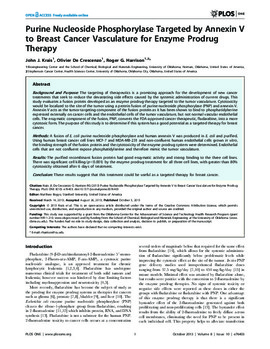| dc.contributor.author | John J. Krais | en_US |
| dc.contributor.author | Olivier De Crescenzo | en_US |
| dc.contributor.author | Roger G. Harrison | en_US |
| dc.date.accessioned | 2015-01-23T17:17:47Z | |
| dc.date.accessioned | 2016-03-30T15:36:05Z | |
| dc.date.available | 2015-01-23T17:17:47Z | |
| dc.date.available | 2016-03-30T15:36:05Z | |
| dc.date.issued | 2013-10-03 | en_US |
| dc.identifier.citation | Krais JJ, De Crescenzo O, Harrison RG (2013) Purine Nucleoside Phosphorylase Targeted by Annexin V to Breast Cancer Vasculature for Enzyme Prodrug Therapy. PLoS ONE 8(10): e76403. doi:10.1371/journal.pone.0076403 | en_US |
| dc.identifier.uri | https://hdl.handle.net/11244/14096 | |
| dc.description | | en_US |
| dc.description | Conceived and designed the experiments: JJK OD RGH. Performed the experiments: JJK OD. Analyzed the data: JJK OD RGH. Wrote the paper: JJK OD RGH. | en_US |
| dc.description.abstract | Background and PurposeThe targeting of therapeutics is a promising approach for the development of new cancer treatments that seek to reduce the devastating side effects caused by the systemic administration of current drugs. This study evaluates a fusion protein developed as an enzyme prodrug therapy targeted to the tumor vasculature. Cytotoxicity would be localized to the site of the tumor using a protein fusion of purine nucleoside phosphorylase (PNP) and annexin V. Annexin V acts as the tumor-targeting component of the fusion protein as it has been shown to bind to phosphatidylserine expressed externally on cancer cells and the endothelial cells of the tumor vasculature, but not normal vascular endothelial cells. The enzymatic component of the fusion, PNP, converts the FDA-approved cancer therapeutic, fludarabine, into a more cytotoxic form. The purpose of this study is to determine if this system has a good potential as a targeted therapy for breast cancer.MethodsA fusion of E. coli purine nucleoside phosphorylase and human annexin V was produced in E. coli and purified. Using human breast cancer cell lines MCF-7 and MDA-MB-231 and non-confluent human endothelial cells grown in vitro, the binding strength of the fusion protein and the cytotoxicity of the enzyme prodrug system were determined. Endothelial cells that are not confluent expose phosphatidylserine and therefore mimic the tumor vasculature.ResultsThe purified recombinant fusion protein had good enzymatic activity and strong binding to the three cell lines. There was significant cell killing (p<0.001) by the enzyme prodrug treatment for all three cell lines, with greater than 80% cytotoxicity obtained after 6 days of treatment.ConclusionThese results suggest that this treatment could be useful as a targeted therapy for breast cancer. | en_US |
| dc.language.iso | en_US | en_US |
| dc.publisher | PLos One | en_US |
| dc.relation.ispartofseries | PLoS ONE 8(10):e76403 | en_US |
| dc.relation.uri | http://www.plosone.org/article/info%3Adoi%2F10.1371%2Fjournal.pone.0076403 | en_US |
| dc.rights | Attribution 3.0 United States | en_US |
| dc.rights.uri | https://creativecommons.org/licenses/by/3.0/us/ | en_US |
| dc.subject | PLOS | en_US |
| dc.subject | Public Library of Science | en_US |
| dc.subject | Open Access | en_US |
| dc.subject | Open-Access | en_US |
| dc.subject | Science | en_US |
| dc.subject | Medicine | en_US |
| dc.subject | Biology | en_US |
| dc.subject | Research | en_US |
| dc.subject | Peer-review | en_US |
| dc.subject | Inclusive | en_US |
| dc.subject | Interdisciplinary | en_US |
| dc.subject | Ante-disciplinary | en_US |
| dc.subject | Physics | en_US |
| dc.subject | Chemistry | en_US |
| dc.subject | Engineering | en_US |
| dc.title | Purine Nucleoside Phosphorylase Targeted by Annexin V to Breast Cancer Vasculature for Enzyme Prodrug Therapy | en_US |
| dc.type | Research Article | en_US |
| dc.description.peerreview | Yes | en_US |
| dc.description.peerreviewnotes | http://www.plosone.org/static/editorial#peer | en_US |
| dc.identifier.doi | 10.1371/journal.pone.0076403 | en_US |
| dc.rights.requestable | false | en_US |

